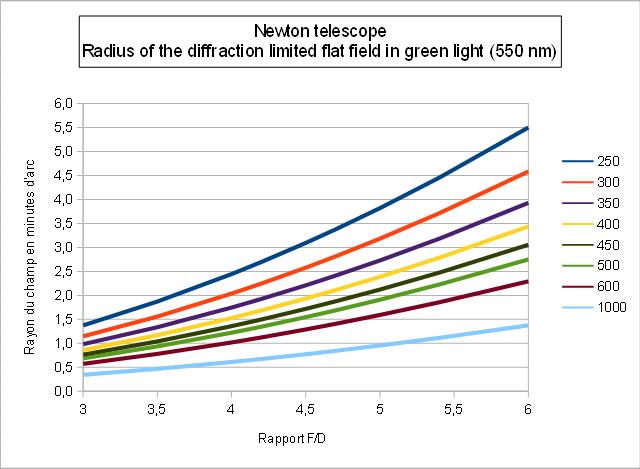Radius of the diffraction limited flat field :
In green light, the radius of the diffraction limited flat field of a Newtonian telescope is given by (reference W1) :
α = 38.2 (F/D)2 / D
with
α : radius of the diffraction limited flat field in arcmin
F : focal length in mn
D : diameter in mm
The diffraction limited field is proportional to the wavelenght (the longer the wavelength the larger the field).
A 500 mm F/3 telescope would just cover the maximum diameter of Venus or Jupiter in blue light. In other words, the collimation, and the centering of the planet on the sensor, should have to be perfect in order to have diffraction limited performances over these planets.


Diameter in pixels of the diffraction limited field :
For high resolution imaging, it would be useless to have a large size sensor (ie. a lot of pixels) if the field covered by the sensor is greater than diffraction limited flat field.
The diameter in pixels covered by the sensor depends on the sampling. Experience shows that a sampling from X3 to X3.5 the resolution limit (ie. Dawes criteria, 117 / D for green light) gives the best results for lunar and solar high resolution imaging.
With a sampling equal to 3 times the resolution limit, the diffraction limited field expressed in number of pixels is equal to :
d = 114.6 (F/D)2
Note : this number of pixels does not depends on the wavelength or on the size of the pixels.
![]()
For example, at X3 sampling, the size of the diffraction limited flat field is equal to 3500 pixels at F/D = 5.5, and only 1050 pixels at F/D = 3.
As a comparison point, the following table gives the size of some sensors used in high resolution imaging.
| Sensor | X | Y | Diagonal |
| ICX 618 | 680 | 480 | 832 |
| E2V 76C661 | 1 280 | 1 024 | 1 639 |
| IMX 174 | 1 936 | 1 216 | 2 286 |
| ICX 674 | 1 936 | 1 458 | 2 424 |
| CMOSIS 4000 | 2 048 | 2 058 | 2 903 |
At X3 sampling, a F/D 5.5 Newtonian would cover a size larger than the CMOSIS 4000, while a F/D 3 Newtonian would only cover the height of the E2V 76C661.
Note on Barlow lens :
All the previous analysis consider that the Barlow lens used to reach the expected sampling ratio has no impact on the diffraction limited flat field, but Barlow lenses may increase or ... decrease the size of the diffraction limited flat field.
More on Barlow lenses here.
Field curvature of Newtonian telescopes :
R = 2 x F